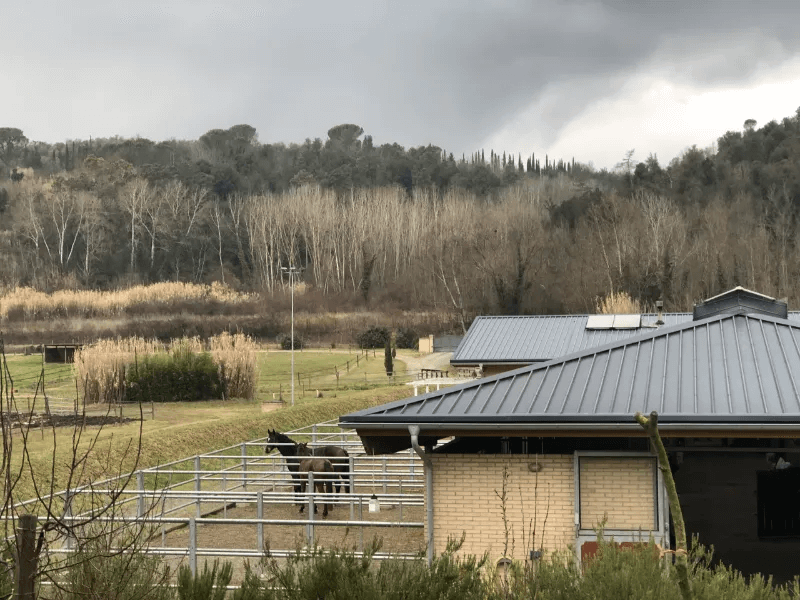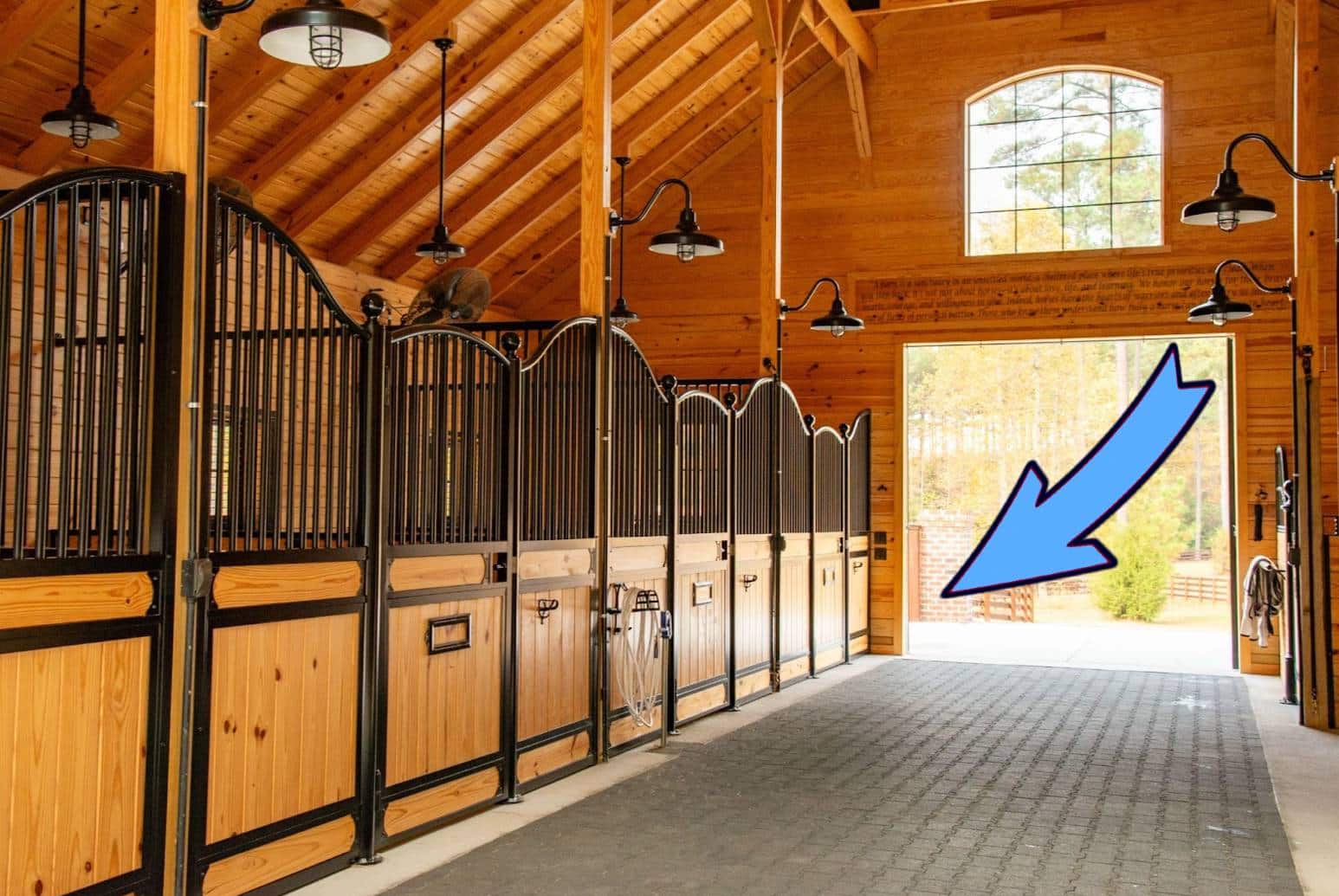An inadequately ventilated barn can become a dangerous environment for horses, with the air often laden with airborne dust, molds, viruses, bacteria, spores, aeroallergens, and gaseous irritants and endotoxins originating from bedding and feed.
Both horses and humans can experience asthma, allergies and symptoms of Chronic obstructive pulmonary disease (COPD) after inhaling these irritants prevalent in barns.
For horse-care providers, this highlights the importance of awareness of respiratory hazards, unhealthy environments, and barn ventilation improvements.

The Impact of Stable Design on Air Quality
Often, the problem of inadequate ventilation lies in a stable’s design. Older barns or those converted from non-equine farming before the 1980s may not be suited to the unique ventilation needs of horses, leading to higher levels of dust and limited airflow.
The ideal barn ventilation design promotes natural airflow through features, like high ceilings, vents, and well-placed, functional barn doors and windows. The design of individual horse stalls also plays a significant role. Since dust and ammonia concentrations are highest in the lower three feet of a stall.
While it’s now common practice to provide stalls with a window, studies actually show that dust and ammonia concentrations are highest in the lower three feet of a stall. This means that it’s vital to have airflow from the floor upward – when a horse lies down to rest, they have no choice but to breathe in air heavy with dust and ammonia.
Beyond structural design, management practices (such as regular cleaning, choice of bedding material, and proper storage of feed) can significantly influence stable air quality.
Indoor Confinement of Horses and the Effects on Respiratory Health
The problem of poor stable ventilation becomes even more pronounced when horses are confined indoors for most of the year and not provided with adequate turnout.
For various reasons, many horse owners choose to keep their horses in stalls year-round, sometimes for up to 23 hours a day. However, this extended indoor confinement increases exposure to dust and poor air quality. Everyday stable activities (such as the use of cleaning chemicals, gasoline from equipment, manure management, contaminated water, and organic materials, like hay and straw) expose both horses and their caregivers to various respiratory risks.
While ventilating your barn properly will benefit your horse’s respiratory health, don’t forget to get your horse outside too.
It’s been shown that horses with respiratory issues do better when they spend more time outside. To support their respiratory health, consider finding ways to maximize their outdoor time when weather allows. This could involve adjusting their feeding schedule or adding small paddocks or runs to their stalls, allowing them to regulate their own access to fresh air.

How to Improve Barn Ventilation and Reduce Respiratory Risks
Respiratory hazards are quite common in barns, but they can be managed proactively in several ways:
- Design barns with respiratory health in mind. Key elements of a “respiratory-friendly” design include ample ventilation, good drainage systems, and dust-free surfaces.
- Identify unique hazards. Understand the safety information of all chemicals used in and around the barn.
- Be conscious of how these hazards may vary depending on the season. For example, mold exposure risk may increase during the rainy seasons.
- Use properly fitted protective face masks or N95 respirators, when necessary, as well as other personal protective equipment (PPE).
- Maintain clean and tidy workspaces and equipment.
- Ensure windows and doors are open whenever possible.
- Use mechanical ventilation systems (fans, exhaust blowers) to remove contaminants.
- Implement strategies to reduce mold growth. For example, store hay at the recommended moisture levels and regularly clean bedding materials.
- Promote overall health for both horses and humans. Regular exercise, a balanced diet, and no smoking contribute to a healthier immune system and better respiratory health.
- Know what to do in case of accidental exposure to a respiratory hazard. A quick response can be crucial to reducing the severity of respiratory distress.
Specialist engineers, builders, and architects are all able to provide helpful recommendations on the best locations for fans and vents in a stable. Additionally, they can advise on which windows should remain open in order to be able to improve natural barn ventilation without spending a fortune.
Many of these specialists draw on knowledge and experience of other agricultural industries that have mastered ventilation systems (like swine and poultry farming) and can therefore be a valuable resource for equestrian projects.
Monitoring Air Quality
Regular monitoring of air quality can also help detect any ventilation issues early, ensuring the effectiveness of airflow strategies.
Unless dust particles are removed through ventilation, stale dust particles in the atmosphere tend to stick around for a long time. An inadequately ventilated barn is an environment that is dangerous for horses: dusty and damp in winter, and stifling in summer, with airborne contaminants (like feed dust, mold spores, and ammonia from urine and wet bedding) irritating the lungs and airways, facilitating virus and bacterial invasion.
A great barn, on the other hand, is designed to optimize horses’ health and well-being, not just to provide comfort for people. Simple observations (like checking for condensation inside, strong odors, or dust in the sunlight) can provide valuable insights into air quality. And more advanced methods – including air sampling and the use of hygrometers to measure humidity – can provide a more comprehensive picture. Remember: if in doubt – seek expert advice.
To improve horse barn ventilation, consider integrating windows, doors, and well-designed stalls that allow for better airflow. Strategically placed barn windows and doors can promote natural ventilation, while stall designs with open tops or adjustable vents can help maintain continuous fresh air circulation.